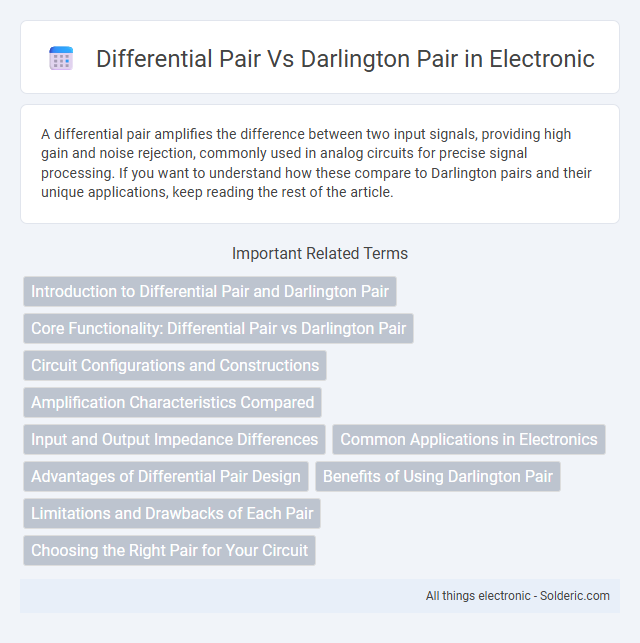A differential pair amplifies the difference between two input signals, providing high gain and noise rejection, commonly used in analog circuits for precise signal processing. If you want to understand how these compare to Darlington pairs and their unique applications, keep reading the rest of the article.
Comparison Table
| Feature | Differential Pair | Darlington Pair |
|---|---|---|
| Definition | Two matched transistors amplifying the difference between two input signals. | Two transistors connected to provide high current gain. |
| Purpose | Amplify differential signals, improve noise rejection. | Increase current gain for driving loads. |
| Configuration | Transistors connected with emitters coupled and inputs at bases. | Transistor emitter feeds base of second transistor. |
| Gain | Moderate voltage gain, high common-mode rejection ratio (CMRR). | Very high current gain (product of both transistor gains). |
| Applications | Operational amplifiers, analog signal processing. | Power amplifiers, switching circuits. |
| Advantages | Noise immunity, precise amplification of differential signals. | High current gain with simple design. |
| Disadvantages | More complex biasing and matching required. | Higher saturation voltage and slower switching speed. |
Introduction to Differential Pair and Darlington Pair
A differential pair consists of two transistors configured to amplify the difference between two input signals, commonly used in operational amplifiers and analog circuits for precise signal processing. A Darlington pair is a configuration of two transistors connected to provide high current gain by cascading their amplifications, typically employed in power amplification and switching applications. Both configurations enhance transistor performance but target distinct electrical characteristics: differential pairs emphasize input signal comparison, while Darlington pairs maximize current amplification.
Core Functionality: Differential Pair vs Darlington Pair
A differential pair consists of two transistors that amplify the voltage difference between their inputs, providing high input impedance and excellent common-mode noise rejection, essential in analog signal processing and operational amplifiers. In contrast, a Darlington pair combines two transistors in a configuration that significantly increases current gain by cascading the current amplification stages, making it ideal for power amplification and driving heavy loads. The differential pair emphasizes precise differential voltage amplification, while the Darlington pair focuses on high current amplification and gain.
Circuit Configurations and Constructions
Differential pairs consist of two matched transistors configured to amplify the voltage difference between their inputs, commonly employed in operational amplifiers for high gain and linearity due to their symmetrical structure. Darlington pairs combine two transistors in a single package where one transistor's emitter feeds into the base of the second, producing a composite device with very high current gain and increased input impedance. The differential pair emphasizes matched conduction paths for differential signals, while the Darlington pair focuses on cascading transistor stages to enhance current amplification in a compact form.
Amplification Characteristics Compared
Differential pairs provide high gain with excellent linearity and common-mode noise rejection, making them ideal for precise signal amplification in operational amplifiers. Darlington pairs offer very high current gain by cascading two transistors, but with slower response and higher saturation voltage compared to differential pairs. Your choice depends on whether you prioritize low-noise, linear amplification or higher current gain in your circuit design.
Input and Output Impedance Differences
Differential pairs typically have high input impedance and moderate output impedance, making them ideal for amplifying small differential signals with minimal loading effect. Darlington pairs exhibit very high input impedance due to the combined transistor configuration but have higher output impedance compared to differential pairs, limiting their effectiveness in driving low-impedance loads. Understanding these impedance characteristics helps you choose the right pair type based on your circuit's signal handling and load driving requirements.
Common Applications in Electronics
Differential pairs are widely used in operational amplifiers, analog signal processing, and instrumentation circuits for precise amplification and noise rejection. Darlington pairs find common applications in power amplification, motor drivers, and switching circuits due to their high current gain and ease of driving high-current loads. Both configurations enhance transistor performance but serve distinct roles in signal integrity versus power handling.
Advantages of Differential Pair Design
Differential pair designs offer superior noise rejection and enhanced signal integrity by amplifying the difference between two input signals while suppressing common-mode noise, making them ideal for precision applications. Their balanced architecture provides better linearity and improved gain stability over varying temperatures compared to Darlington pairs, which tend to have higher voltage drops and slower response times due to their cascaded transistor configuration. You benefit from lower distortion and increased bandwidth in differential pair circuits, essential for high-performance analog signal processing.
Benefits of Using Darlington Pair
Darlington pairs offer high current gain by combining two transistors in a single package, enabling amplification of weak signals without the need for additional components. Their high input impedance and strong output drive capability make them ideal for switching applications and loads requiring significant current. This configuration enhances overall efficiency and reduces circuit complexity compared to single transistor stages.
Limitations and Drawbacks of Each Pair
Differential pairs often suffer from limited gain-bandwidth product and increased complexity in biasing and matching, which can lead to offset voltage and reduced linearity in precision applications. Darlington pairs exhibit significant drawbacks including higher saturation voltage, increased input capacitance, and slower switching speeds, which can limit their efficiency in high-frequency circuits. Your choice between the two should consider these limitations carefully, especially regarding power consumption and signal integrity in specific use cases.
Choosing the Right Pair for Your Circuit
Choosing the right pair for your circuit depends on the specific application requirements such as gain, linearity, and input impedance. Differential pairs excel in providing high linearity and common-mode noise rejection, making them ideal for amplifier input stages and analog signal processing. Darlington pairs deliver very high current gain suitable for switching and power amplification but may introduce higher voltage drops and slower response times.
Differential pair vs Darlington pair Infographic

 solderic.com
solderic.com